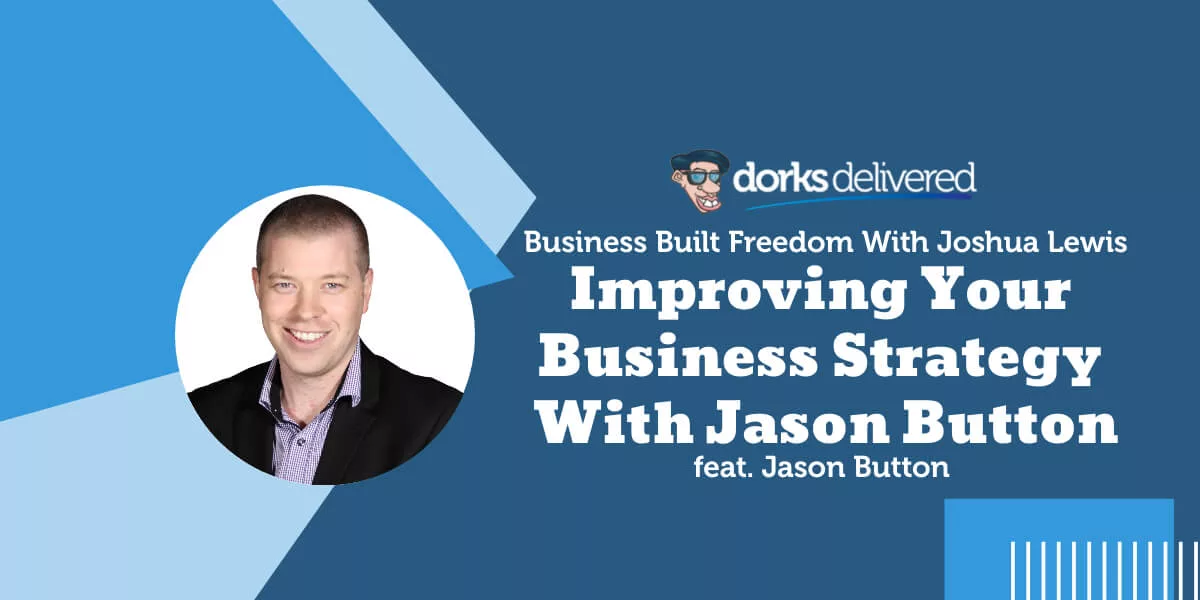Improving your business strategy is a fundamental aspect of making your business better. It helps your company stay competitive, adapt to changes in the market, and achieve its goals and objectives. Jason Button from JB Strategic is a business strategy expert who has a strong background in government and private sector experience as well as in stakeholder management. Jason joined Josh to discuss how every business can improve their strategy so they can continue to grow and succeed in the long term.
Improve Your Business Strategy
1. Know Your Why

The exercise that I’ll generally go through with people in this position is you’ve got to turn off all the noise around you. Take the emotion away and then think of why you are in business. What do you want to ultimately achieve within that?
The other things to take into consideration with your strategic plan is how to tie in things like your vision, mission, objectives and how you are going to achieve everything as well as the “who” and “what” of the business plan.
2. Know Your Customers’ “Why”
Knowing your customers’ “Why” as well as the business’ “Why” and objectives will make your life in business much easier. When you start to look at your business from a customer’s point of view with whatever product or service offering that you’ve got, there has to be some sort of alignment. That’s not to say that it’s got to be exactly the same, but there’s got to be some sort of an element that ties both of those things together for you to have a really strong value proposition, which you can live and breathe in your employees or contractors or whoever is working within your business or organisation.
From the customer’s perspective, they start to understand what your value proposition is and how that ties into whatever the offering is and ticks that box for them.
Business doesn’t have to stop just because you have to get some time off. Find out how our dorks can help.
3. Know Why People Choose You
What our business looks at is getting feedback from your existing customer base and suppliers. Go and talk to your employees or contractors. You could go to friends and family just to get that sounding board and start to really shake that up.
If the feedback that you’re receiving isn’t lining up with your “why”, there is something amiss at that point. There’s got to be some realignment because the “why” stitches everything together and where you want to head. If you can’t get that alignment and what you’re projecting out there, there’s got to be some time and attention spent on that.
How much time to spend on improving your business strategy?
If you’ve genuinely got some concerns in your “why”, I encourage anyone to take the time. When we’re all stuck in the grind, Monday to Friday is not the time to do it. You need to get away from
Have some time on that and start to line it up starting with the feedback. There is absolutely no reason why you can’t spend time on this during the different phases of your life. You’ve always got to get that alignment and revisit your “what” on a regular basis.
Revisit Your Why on a Regular Basis
You’ve also got to start to spend time looking at your “Why” on a regular basis. I work with clients, and we re-evaluate our “why” on an annual basis and then that starts to shape that strategic plan. We do it on a financial year basis, but that doesn’t mean you can’t do it on a calendar year basis or whatever suits you, whatever you’re comfortable with. What’s really important is to always bring that back to your “Why” while you can.
Guaranteed uptime or you get paid! Let’s talk about business continuity.
The 4 Ps and Your Why 
Jason: Whenever I’m looking at a strategic plan, I look at the 4 Ps: plans, people within the business (i.e. internal stakeholders), process (i.e. how we go about certain things), and the purchaser (i.e. customers). I love to just segregate the 4 Ps into four quadrants there, start with those areas and start to drill down. You might write your “Why”—the value proposition—right in the middle of that.
1. The People
Start to look at what’s the value of all your people. We start that with a survey to get some feedback and we might do a bit of an audit on the skills and experience. We look at career pathway mapping, the culture within the business, how engaged they are, what sort of capacity we’ve got. There are so many different things that we can look at with just our People.
2. The Plan
When I say Plans, we also have to look at the timeframe. When do I want to achieve X, Y and Z? Taking it back to your book, I think it’s really cool that you’ve got a reference point to go back to when you put your strategic hat on. Start to look at your plans at that snapshot in time. Then, look at any outside influence or any change to your “why” and then update that to ensure that you’re on the right track. That’s sort of a lot of planning.
Improve your processes. Book your free, no-commitment consultation with a dork.
3. The Purchaser
Jumping across to the purchaser, it’s looking at your “why” standpoint from your customer side of things. It’s improving the experience and communicating the value proposition. You need to do some thinking on how you communicate that effectively to customers and make sure you’ve got the right customers.
4. The Process
In terms of your process, what are you doing in terms of capturing your training internally so that it can be replicated for new people coming into the business? I can come up with your “What” proposition quickly and look at all documented actions.
Should you automate? Book your free consultation with a dork to find out.
Profitability and Efficiency
This is going to seem a bit funny, but a great way to demonstrate profitability and efficiency is to pretend that we’re at a restaurant. If you watch MasterChef, there was this little trend called deconstructed everything. They deconstructed desserts and other food.
Everyone knows what a pavlova looks like, but then you get a deconstructed pavlova—may still taste nice, but you just haven’t had the time to do it so you’ve done all the elements separately. That can often happen in business when we’re talking about process. Just because we are making money, it doesn’t mean it’s the most efficient way to do it.
I’d like everyone to look at their business and what they’re offering once it hits the purchaser or the customer. Am I serving up a whole pavlova dessert in its completion or is it a bit of a deconstructed base where I’ve got a lot of good little elements and they’re still leaving you satisfied, but it’s still not quite right?
If you want to contact Jason from JB Strategic, jump across to his LinkedIn profile.
An Extra Pair of Eyes Helps
It’s always good to zoom out of your business and spend some time looking at what your strategies for those areas are. Look at those 4 Ps—the people, the plan, the process and your purchasers—so you can get the most out of your business and yourself. You’re a happier individual with it as well.
What if technology can help you achieve your goals but you just didn’t know it? Book your free discovery session with a dork.
What should NOT be in your business strategy?
1. No Accountability
A bad business strategy for me is one that is missing any sort of accountability.
2. Unrealistic Timeframe
You need timeframes that are achievable. You’ve just got to understand and get a feel. Don’t bite more than you can chew and make things too ambitious. Make it so that it is achievable and will push you out of your comfort zone. Let’s just make sure that it’s something tangible and achievable and we know the steps to get to the final point.
Don’t get hung up on the design of your plan, the front cover and the pages, and the look of it. That’s where we all sit and procrastinate. Rip the Band-Aid off and then you can come back tomorrow and start to put a bit of a sense to it. It’s sometimes the best way to go about that.
It’s really important that you set your goals and then work backwards from that—what it’s going to take, what the steps are, and then go back and look at those 4 Ps of how they’re going to help you achieve that.
If you want to contact Jason from JB Strategic, jump across to his LinkedIn profile.
We specialise in improving processes to boost your businesses’ profitability and efficiency. Call 07 3166 5465 to enquire!
[module-379]































